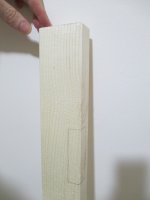MichaelW2014
Member
- Joined
- Jan 3, 2014
- Messages
- 276
Hello everyone. I am a festool owner, I recently bought a ct midi and a router 1010. but my question today is regarding making a french cleat out of part of a beam of wood. I understand that french cleats can be ripped on a table saw or track saw, or can be cut out using a router table; they can also be made using the carvex 420. but what i am trying to do is cut a french cleat slot out of Part of a piece of wood, not the entire length. As of now, the best way i can think of doing this is with a hand saw and the carvex. I would start by making a hole for the carvex blade to start at, then i would carvex my way to each end of the length that i need to be removed. I have attached an image of a beam just to help us get on the same page. I want to make the cleanest cuts possible. I will buy the tools that allow me to best achieve this goal, withing reason and so long as they are feasible given the size limitations of my small indoor wood-shop. Please let me know what is best. thanks




